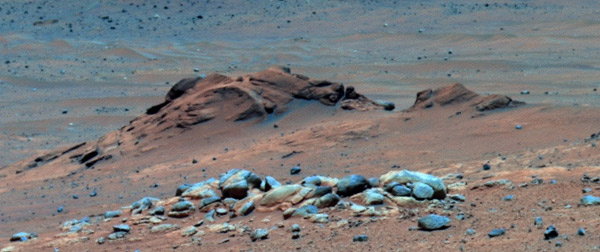Rare Mars Rock Holds Clue to Ancient Water

Crafty detective work based on data from NASA's Mars rover Spirithas uncovered large amounts of a rare type of Martian rock that adds moreevidence that the red planet may have harbored liquid water in the ancient past.
The rock outcrop is rich in carbonate minerals and was foundin the Columbia Hills, an "island" of low hills at Spirit's Gusevcrater home on Mars. Spirit visited the outcrop in 2005, before it got permanentlystuck in its current Martian resting spot.
Carbonates are minerals that contain carbon dioxide and formreadily in the presenceof water. So, if the conditions were such that carbonate-bearing rocks wereable to form, this would suggest that at one point, water ? and possibly anenvironment favorableto primitive life ? was likely present in the region.
"Carbonate forms as a precipitation product from water,so there has to be water around for them to form in the first place," thestudy's lead author Richard Morris, a planetary scientist at NASA's JohnsonSpace Center in Houston, Texas, told SPACE.com.
There is, however, no firm evidence that Mars has everhosted life.
Hunting rare Mars rocks
Until now, geologic clues for the presence of carbonates onthe Martian surface have been relatively scarce. In contrast, carbonate-richrocks (such as limestone) are plentiful on Earth, where liquid water abounds.
Breaking space news, the latest updates on rocket launches, skywatching events and more!
The discovery of the carbonate-rich outcrop came as asurprise to researchers, since plenty of rocks that did not contain carbonateswere previously found in the surrounding area.
"[The rocks] were found on the southeast lobe ofHusband Hill in the Columbia Hills," Morris said. "As Spirit wascoming down slope on Husband Hill, we encountered a lot of rocks that don'thave carbonates. We ran into this outcrop, analyzed it, and noticed that it wasvery different at the time, but didn't really appreciate why until prettyrecently."
The Spirit rover actually visited the outcrop, calledComanche, back in December 2005, and while initial measurements were taken, thesignificance of the finding only recently became apparent. ?
"It took us a long time and a lot of detective work tofigure this out," Morris said.
Spirit and its robotic twin Opportunity have been exploringdifferent parts of Mars since they landed in January 2004. Now in their seventhyear on Mars, the rovers have far outlasted their initial 90-day mission.
Last year, Spirit got stuck in deep Martian sand and NASAgave up trying to extract it earlier this year. The rover is currentlyhibernating and may not survive the harsh Martian winter.
Opportunity, meanwhile, is doing fine as it heads to a hugecrater called Endeavour. Last month, the rovers? broke the record for the longestmission on the surface of Mars.
Red planet detectives
The researchers employed the full suite of MarsExploration Rover (MER) instruments to make their discovery, including theAlpha Particle X-ray Spectrometer, which provided an early clue by detecting theuncharacteristic excess of light elements in the rock, and the MiniatureThermal Emission Spectrometer (Mini-TES), a mineral-scouting instrument thatidentified the carbonate minerals.
When Spirit initially visited Comanche in 2005, theMini-TES, which was developed at Arizona State University (ASU), had beenunable to readily detect the carbonates in the rock because the instrument waspartially blinded by Martian dust.
"Mini-TES got dusted months before Spirit reachedComanche, and we didn't have a good way to correct for the dust effects at thetime," said Steve Ruff, a research scientist at ASU's Mars Space FlightFacility, and one of the study's researchers. "We knew there was somethingweird about the outcrop's spectrum as seen by Mini-TES, but couldn't say what causedit."
"Spirit's Mossbauer spectrometer indicated thatcarbonate was possible, but I didn't believe it," Ruff added.
The researchers developed a calibration to remove thespectral effects and correct for the dust that had gotten into the instruments.Combined with the Mossbauer data and chemical data from a third spectrometer,the Mini-TES was able to confirm the carbonate minerals in the Comancheoutcrop.
The precise sizes of the rocks are difficult to measure,Morris said, because a lot of them are buried beneath the Martian surface.
"There's a large outcrop that is roughly five meters(about 16 feet) across," he said. "The ones we did most of themeasures on were mostly 1.5 meters (almost 5 feet) across."
The research is detailed in the online June 3 edition of thejournal Science.
How did they form?
The researchers are hoping that analysis of the rocks'composition could also provide evidence for how they were formed.
"The Martian carbonates have a bit of an unusualcomposition," Morris said. "This has got to be telling us something.The next step is to look into the processes that formed these carbonates."
The mineral is rich in magnesium and iron and possiblyoriginated via hydrothermal processes ? forming through precipitation from thehot, residual waters from leftover magma that flowed through buried deposits ofcarbonate minerals, said Morris.
Moving forward, the researchers will now examine terrestrialrecords to find carbonates that have similar compositions to those found onMars. Knowing how much carbonate is present in the rock will allow the scientiststo use analog examples from Earth to understand how they might have formed.
Tracking Mars carbonates
Scientists have been searching for carbonate rocks on Marsfor decades, as such minerals are crucial to understanding the early climatehistory of the red planet, and the tangential question of whether Mars mightonce have hostedlife.
In fact, small amounts of carbonate minerals have previouslybeen detected on Mars.
The Martian meteorite ALH 84001 contained approximately 1-2percent carbonate, and until the Comanche discovery, was thought to have thehighest concentration of carbonate of the rocks found on Mars at the time.
The Comanche outcrop, however, is far more abundant,containing between 16 and 34 percent carbonates.
Morris believes that there is a possibility thatcarbonate-rich rocks could also be found in other regions of Mars. Carbonminerals have been detected in the Nili Fossae region of Mars, which is about 3,900miles (6,300 kilometers) away, opening the door to similar findings in thefuture.
Ruff said "the Comanche data have been available toscientists and the public for about four years now. The new finding shows thatthis data set still harbors potentially major discoveries."
"Do other surprises await us?" Ruff wondered."Who knows? But I'll make a strong prediction: More discoveries will bemade with old data."
- Mars Rovers Most Amazing Discoveries
- Some Mars Channels Carved by Lava, Not Water
- Images ? Mars: A Spacecraft Graveyard

Denise Chow is a former Space.com staff writer who then worked as assistant managing editor at Live Science before moving to NBC News as a science reporter, where she focuses on general science and climate change. She spent two years with Space.com, writing about rocket launches and covering NASA's final three space shuttle missions, before joining the Live Science team in 2013. A Canadian transplant, Denise has a bachelor's degree from the University of Toronto, and a master's degree in journalism from New York University. At NBC News, Denise covers general science and climate change.
